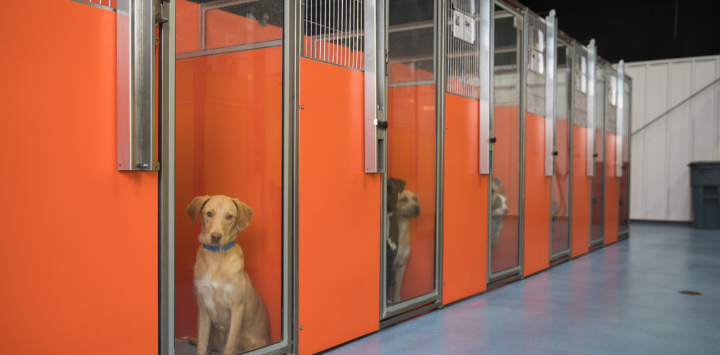
Kick your old kennel cards to the curb in favor of more effective designs
There’s something to be said for the standard kennel cards so many shelters use. Since you can print them directly from your database, it’s easy, time-saving, and has all the information you need at a glance (e.g., “A” numbers, vaccine history, intake date). But standard cards don’t have the kind of details wanted by people looking to adopt. In some cases, staff and volunteers jot down “helpful” comments on the tiny amount of space available, though that isn’t always beneficial, either. The worst card I’ve ever seen included the note: “This cat is bipolar!”
Ouch. So much for using kennel cards as effective marketing tools.
“Kennel cards are really the bulletin board to talk about how amazing the animals in your care are, and to advertise them and to get them noticed among the many,” says Kristen Hassen, principal of Outcomes Consulting, in the HSUS Animal Sheltering magazine article “Little card, big message.” (You can read a list of Do’s and Don’ts she created here.)
Good news, though: there are plenty of good examples of redesigned cards available for the taking. In a time when we can use every bit of help that we can get to find homes for the animals in our care, these are resources every shelter should be using.
Simplifying and using templates
A new design doesn’t have to be complicated. Pima Animal Care and Control in Tucson, Arizona, redid its cards a few years ago to simplify them while still incorporating key details that would resonate with the public.
“We wanted to declutter and make them as informative as possible, but also readable,” says PACC executive director Monica Dangler. “We updated the cards to have icons like ‘playgroup rockstar’ or ‘lived with dogs’ so that we could more clearly communicate the dogs’ personalities to adopters and to cut down on people writing things on the cards. We also redesigned them to look more inviting and friendly.”
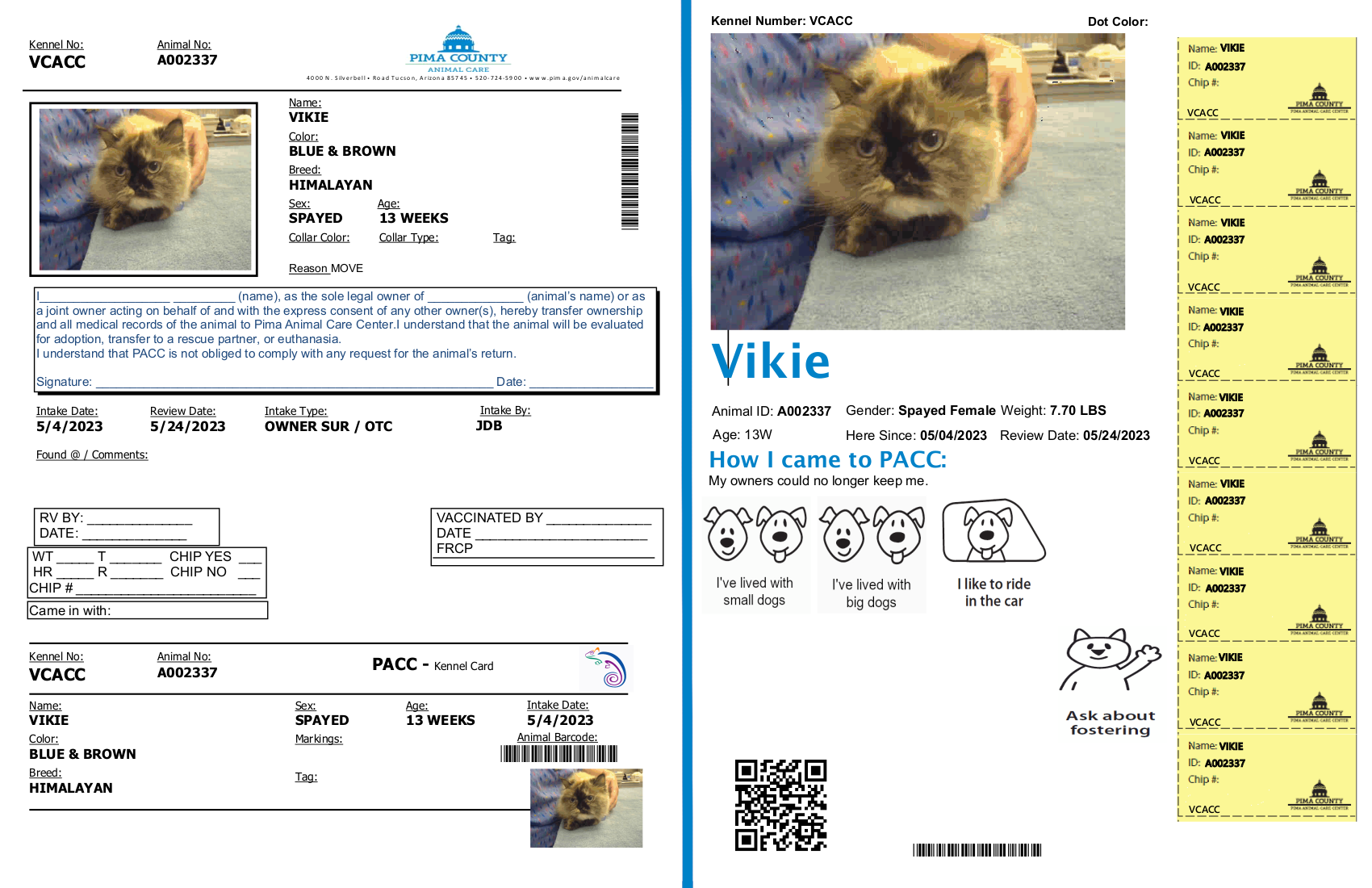
Fulton County Animal Services (managed by LifeLine Animal Project) in Atlanta, Georgia, still uses its standard Chameleon-generated cards for explicit info that the shelter staff needs, but they hang a new version of the card on the kennels as well.
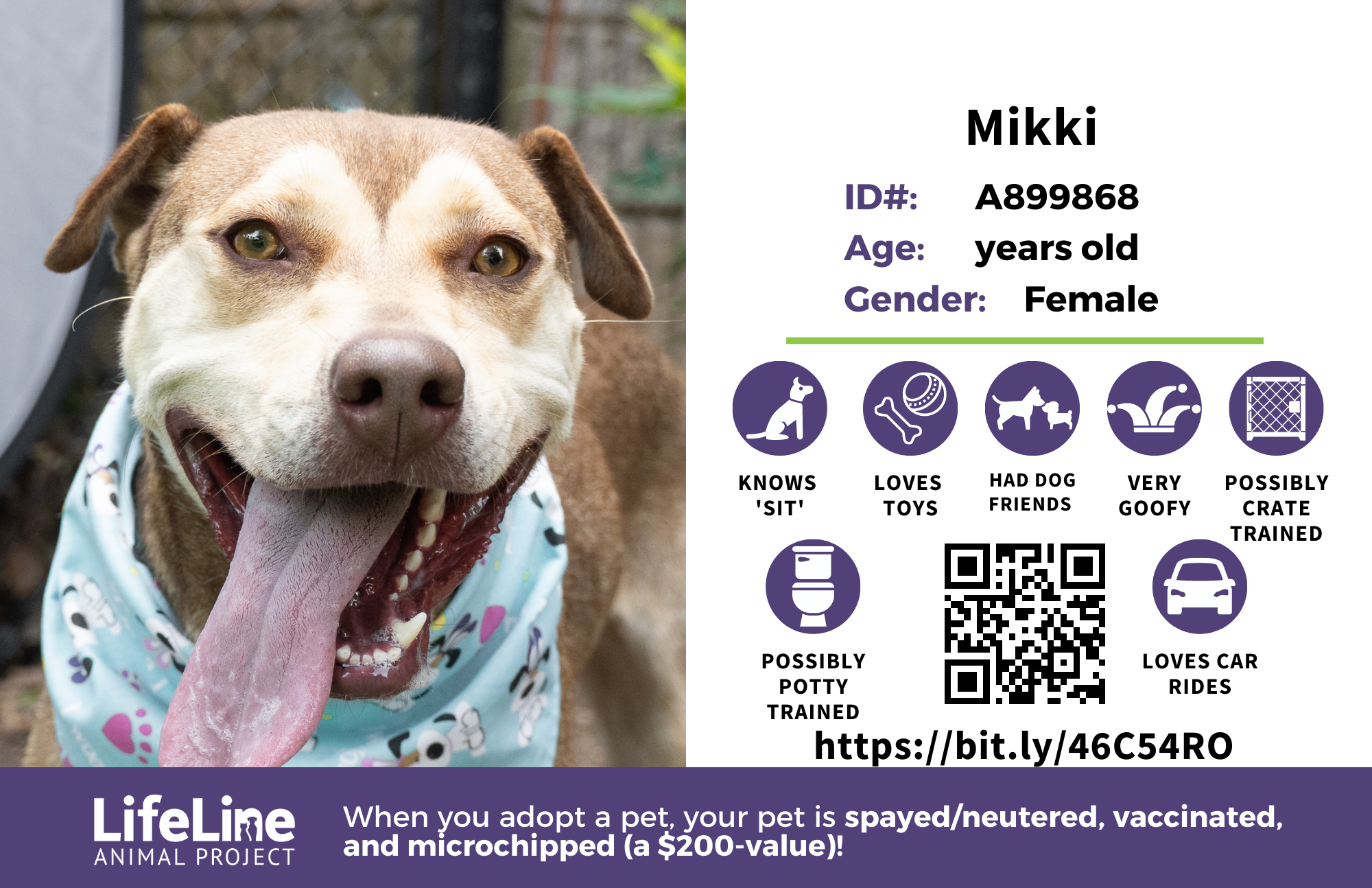
“The new cards are a more visually appealing way for visitors to browse dogs that meet their interests, and the pops of color are nice-looking in the drab kennels,” says Erica Beard, Lifeline’s placement manager. “Posting these on our social media adoption pages has been helpful as well because everything about the dog is right there in one image.”
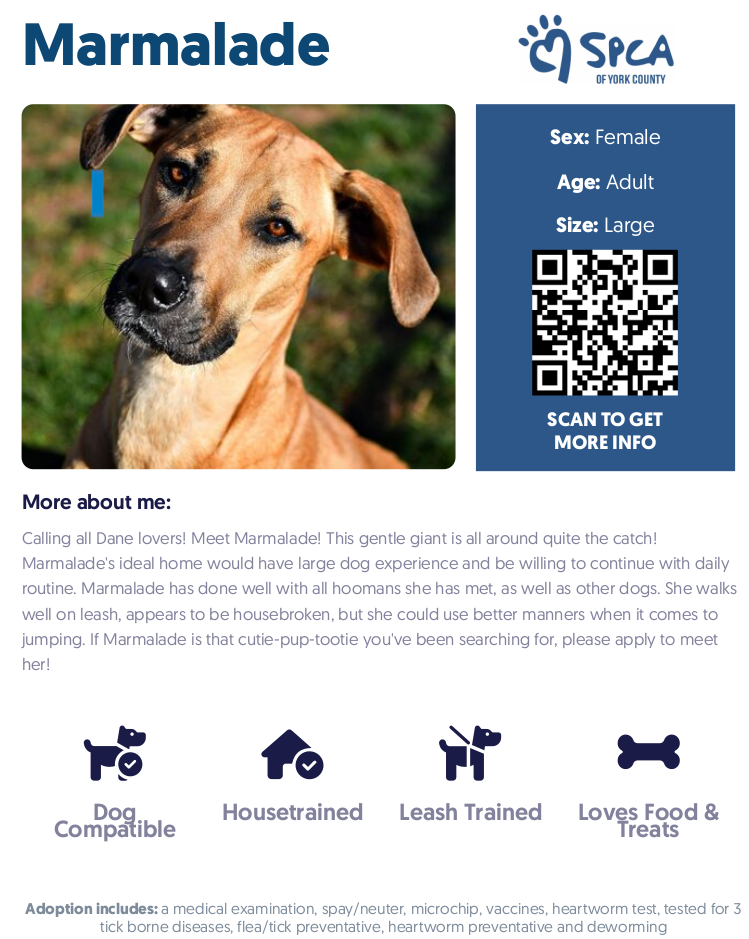 For the past three years, Dr. Natalie Weekes, VMD, shelter medical director at York County SPCA (YCSPCA) in Pennsylvania, has focused on not just creating new cards, but also on building a shareable toolkit (PDF) covering the why, how, and benefits of their new designs.
For the past three years, Dr. Natalie Weekes, VMD, shelter medical director at York County SPCA (YCSPCA) in Pennsylvania, has focused on not just creating new cards, but also on building a shareable toolkit (PDF) covering the why, how, and benefits of their new designs.
“This has been my passion project,” says Natalie. “Our earlier kennel cards were index cards that said when the animal came in and if it was stray or owner surrender but had no information for adopters. In early 2020, I started to create a template in Adobe that we could use in-house to make the cards more visually appealing.”
Incorporating technology
More than just a revamp of kennel cards, the toolkit Natalie created shows how YCSPCA incorporates new technology by using QR codes. Working from funding granted by the Pedigree Foundation Dogs Rule and collaborating with the pet adoption management system Adōpets, she created the interactive Shelter Scan cards with the intent for them to be used by other shelters across the world.
The new designs are much larger than YCSPCA’s earlier kennel cards; they’re now a full sheet of 8 x 10 paper for the dogs and a half sheet for the cats. They feature a large color photo, a small description of the animal, fun icons for pet characteristics, and a QR code that can be scanned with a smartphone. The QR code links to that animal’s page on YCSPCA’s website, where people can see more photos, videos, and a longer biography. They also can apply to adopt the animal while standing in front of the cage or kennel.
“People have definitely been using the QR codes; we see them scanning them all the time,” Natalie says.
Each shelter’s QR code destination may be customized depending on its digital platform. If a shelter does not have an organizational website, they can still use the interactive kennel cards with an outside company landing page such as Adōpets, Petfinder, or Facebook.
“The solution isn’t a unique idea, but our execution is unique,” says Steven Martinez, YCSPCA’s executive director. “That’s because we designed the kennel card to be free for any shelter to use and adaptable to any technology infrastructure (or lack thereof).”
(Re)Considering breed labels
In addition to adding helpful information, when considering what is not necessary to include, more shelters are choosing to remove breed labels. Animal Farm Foundation also has a great resource to help explain to the public why breed labels are being phased out (Best Friends has a good resource, too; full disclosure, however, it was written by me) but it is primarily because guesses about dogs’ breeds are usually wrong. Some studies even show that removing breeds from kennel cards cuts down on how long dogs stay at shelters. The study “A label’s a label, no matter the dog” by Nicole Passmore Cohen, et al, found that the median length of stay of a dog at Bideawee in New York decreased by 11.3 days once breed labels were removed (as compared to when breed labels were in place).
Though shelters may feel like they must give potential adopters breed information, as Kim Wolf, founder and executive director of the nonprofit Beyond Breed, astutely notes in “Little card, big message:” “Why would you give them information that’s likely false?” Though if you know the dog’s breed because you have pedigree papers or a DNA test, share that.
Luckily, shelter software systems are changing to allow organizations to use mixed or unknown in the breed field, but dropping any mention on kennel cards creates an opportunity to talk about who each individual dog is rather than what breed they appear to be.
Using kennel cards for multiple purposes
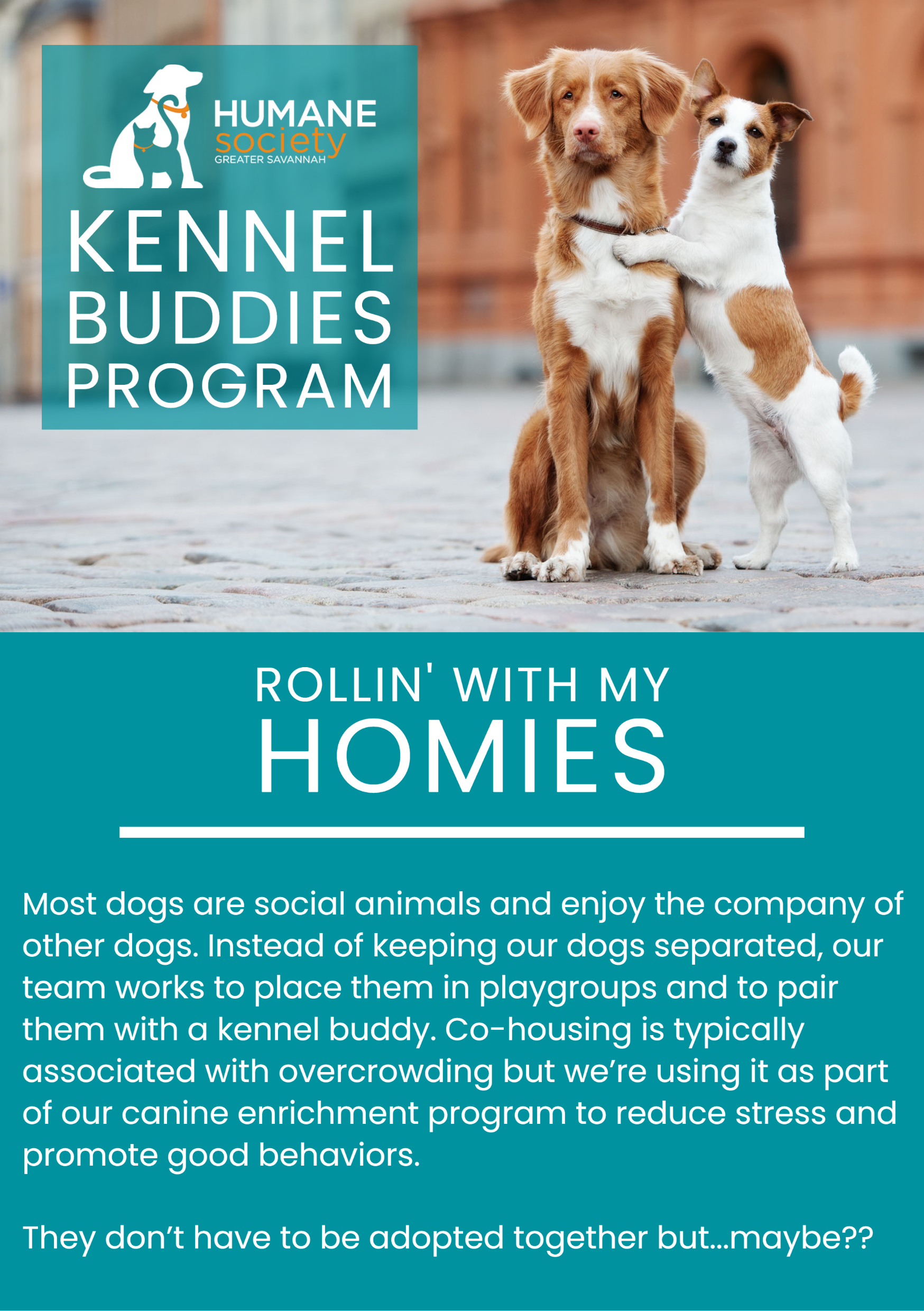 Humane Society for Greater Savannah (HSGS) in Georgia began using specific cards, called Kennel Buddies, when they started cohousing their dogs last year. The shelter had never considered pairing up their dogs, but the idea was suggested by Kristen during a conference call to discuss building out a playgroup program.
Humane Society for Greater Savannah (HSGS) in Georgia began using specific cards, called Kennel Buddies, when they started cohousing their dogs last year. The shelter had never considered pairing up their dogs, but the idea was suggested by Kristen during a conference call to discuss building out a playgroup program.
“We use the Kennel Buddies program selectively and our trainer and volunteers work within the playgroups to identify dogs who would benefit from a buddy,” says Sean Griffin, HSGS’s executive director.
The cards were designed to be funny but also to explain to visitors and potential adopters that HSGS is cohousing by choice, not by necessity.
“We want our adopters to know and feel that the dogs are well cared for, that we work with them and get to know their personalities,” Sean says. “It’s an important distinction to make that we are not cohousing due to overcrowding.”
Enlisting volunteer support
One of the unexpected outcomes of these additions to HSGS’s behavior and enrichment program has been volunteer engagement and retention.
“They love helping our team form playgroups and find Kennel Buddies and have been trained up to the point where they basically run these programs under the supervision of our trainer and staff,” he says.
And, of course, the buddy system is beneficial to dogs.
“It's been particularly helpful for some of our more anxious dogs,” Sean says. “We still choose to feed our cohoused dogs separately to avoid any potential resource guarding, but we have not had any major issues or concerns otherwise.”
Finally, at a time when shelter staff may feel too overwhelmed to even consider changing something that “works” — albeit to a minimal degree — designing new cards is a task eagerly welcomed by volunteers.
“They have been the ones solely creating our new cards from start to finish,” says Erica. “Making them, printing, laminating, and hanging them — we literally could not do it without them.”

Liz Finch
Senior Writer
Best Friends Network
If you enjoyed this program spotlight, you can find our complete catalog of spotlights here.